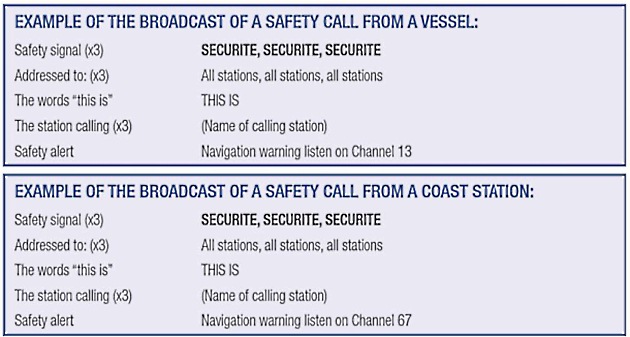Effective communication is the cornerstone of any successful operation, and in environments where direct verbal contact is not feasible, radio communication becomes indispensable. However, the efficacy of radio communication hinges on adherence to standardized radio calling procedures. These procedures ensure clarity, conciseness, and accuracy in message transmission, minimizing misunderstandings and optimizing response times.
Whether in aviation, maritime operations, emergency services, or military contexts, a thorough understanding and strict application of these procedures are paramount. This article delves into the intricacies of radio calling procedures, exploring their fundamental principles, common protocols, and best practices for seamless communication.
Routine Calling Procedures
Routine Calling
Before transmitting, the operator should listen for a period long enough to be satisfied that harmful interference will not be caused to communications already in place.
Marine VHF Channels established for calling purposes are not to be used for the exchange of routine messages.
When using DSC (Digital Selective Calling) Procedures for VHF – MF and HFradiotelephony channels in the VHF marine band and communications are good, the initial call would be as follows:
- the name and/or other identifying information of the station being called, spoken once only;
- the words THIS IS;
- the name and/or other identifying information of the station calling, spoken twice;
- the purpose of the call;
- the suggested working channel for the exchange of messages; followed by
- the word OVER. (The invitation to reply)

Replying to Calls
The coast station reply would be:

At this point both stations change to the suggested working VHF channel and the vessel initiates the call again.
Transmission without station identification is forbidden. Once contact has been established, station identification may be shortened to just the station name:

The coast station receives and acknowledges the position report:

At this point both stations return to monitoring Channel 16.
Repeating calls
If no immediate reply is received to the initial call, wait two minutes and repeat the call. After two calls, wait a further three minutes before calling again. At this point it may be necessary to call another station or to consider whether the required station is in range. Restrictions with regard to repetition of calls do not apply to Terrestrial Urgency and Safety Communications on the Vesselsdistress or urgency calls.
Difficulties in establishing contact with other stations
When a station receives a call and is not certain for whom the call was intended, it should not reply. Instead it should wait for a repetition of the call. When a station receives a call which is intended for it, but is uncertain of the caller, then the called station may reply requesting the identity of the calling station.
Distress Calling Procedures
Responsibility
State and Territory police forces, using the resources of recognised volunteer marine rescue organisations, as well as their own The Role of the RCC in the GMDSSWater Police, co-ordinate most inshore boating emergencies.
Authority to transmit a distress call and message
A distress priority message may only be sent on the authority of the master, skipper, or the person responsible for the safety of the vessel.
Channel for distress
Channel 16 is the International Marine VHF channel for NON-DSC Terrestrial Distress Communicationsradiotelephony distress communication. In Australian waters, VHP Channel 67 is of supplementary channel to Channel 16.
Distress alert
If the equipment is installed onboard, priority should be given to transmitting a DSC Distress Alert on VHF Ch 70 followed by the distress call and message by voice on VHF Ch 16.
The distress signal
The distress signal is the word MAYDAY. The transmission of the Distress Signals and Distress Trafficdistress signal indicates that the vessel, or persons onboard that vessel, are in GRAVE AND IMMINENT DANGER and require immediate assistance.
The distress call
The distress call and message is broadcast to ALL STATIONS, in the SIMPLEX mode of transmission. The radiotelephony distress call consists of:
- the distress signal MAYDAY, spoken three times;
- the words THIS IS;
- the name and any other identity of the vessel in distress, spoken three times.
The distress message
The radiotelephony GMDSS Distress and Safety Communicationsdistress message consists of:
- the distress signal MAYDAY;
- the name and any other identity of the vessel in distress;
- particulars of its position;
- the nature of the distress, the kind of assistance desired;
- any other information which may facilitate rescue; followed by
- the word OVER, the invitation to respond.
The distress call and message may be repeated as often as necessary until an answer is received.
Read also: Inmarsat: A Guide to Satellite Communication
If no answer is received on distress channels, the message should be repeated on any other available channel where attention might be attracted, e. g. a relevant VHF marine repeater channel.
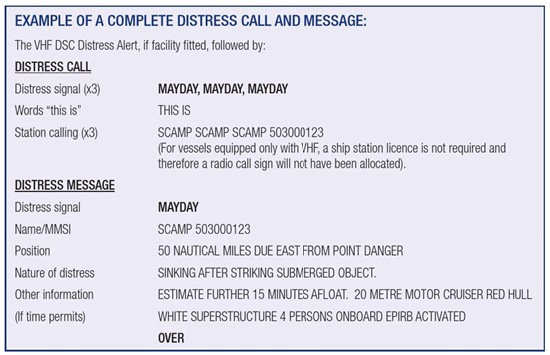
Distress position information
Preference should be given to indicating the position by latitude and longitude (degrees and minutes and decimal points of a minute if necessary, North or South, East or West); or true bearing and distance (the unit of distance should always be specified, for example, nautical miles or kilometres) from a known geographical point (for example 045 degrees true from Point Danger, 24 nautical miles); or a precise geographical location (for example, in the case of a vessel running aground). Where latitude and longitude are not used, care must be taken to ensure that the position given cannot be confused with any other place or geographical point.
If afloat and drifting, the rate and direction of drift could be stated in the distress message.
Distress traffic
All communications relating to the immediate assistance required by the vessel in distress, including search and rescue communications and on-scene, should use the distress signal MAYDAY to precede each call and message.
Acceptance of distress calls and messages
The obligation to accept distress calls is absolute and they must be given priority over all other communications.
Authority to transmit a distress acknowledgement
A distress acknowledgement may only be sent on the authority of the master, skipper, or the person responsible for the safety of the vessel.
Obligation to acknowledge receipt of a distress message
Ship stations that receive a distress message from another vessel which is, beyond any possible doubt, in their vicinity, should immediately acknowledge receipt. However, in areas where reliable communications with a coast station is practicable, ship stations should defer this acknowledgment for a short interval to allow the coast station to acknowledge receipt.
Ship stations which receive a distress message from another vessel which, beyond any possible doubt, is not in their vicinity should defer their acknowledgment to allow vessels nearer to the distressed vessel to acknowledge without interference.
Ship stations which receive a distress message from another vessel which, beyond any possible doubt, is a long distance away, need not acknowledge receipt unless this distress message has not been acknowledged by any other station.
When a ship station hears a distress message which has not been acknowledged by other stations, but is not itself in a position to provide assistance, it should acknowledge the call and then take steps to attract the attention of a coast station or vessels which might be able to assist.
Acknowledgment of receipt of a distress message
Acknowledgment of receipt of a distress message by a vessel or coast station should be made in the following way:
- the distress signal MAYDAY;
- the name and any other identity of the station sending the distress message, spoken three times;
- the words THIS IS;
- the name and any other identity of the station acknowledging receipt, spoken three times;
- the word RECEIVED;
- the distress signal MAYDAY.
- OVER.
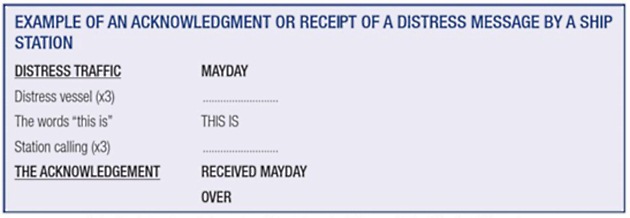
As soon as possible after this acknowledgment a ship station should transmit the following information:
- its position;
- the speed at which it is proceeding; and
- the approximate time it will take to reach the distress scene.
Control of distress traffic
The control of distress traffic is the responsibility of the vessel in distress. However, this station may delegate the control of distress traffic to another vessel, or coast station.
The ship in distress or the station in control of distress traffic may impose silence on any or all stations interfering with distress traffic by sending the instruction SEELONCE MAYDAY.
This instruction must not be used by any station other than the ship in distress, or the station controlling distress traffic. Any station which has knowledge of distress traffic and cannot provide assistance should continue to monitor the traffic until such time that it is obvious assistance is being provided. Any station which is aware of distress traffic, and is not taking part in it, is forbidden to transmit on any channel which is being used for that traffic.
It will be interesting: Inmarsat M & B: Understanding the System and its Services
Ship stations not involved in the exchange of distress traffic may, while continuing to monitor the situation, resume normal radio service when distress traffic is well established and on the conditions that distress traffic channels are not used and no interference is caused to distress traffic.
Resumption of normal working
When distress traffic has ceased on a channel that has been used for distress traffic, the station that has been controlling that traffic should transmit a message addressed to all stations indicating that normal working may be resumed. The message announcing resumption of normal working should take the following form:
- the distress signal MAYDAY;
- the call ALL STATIONS, spoken three times;
- the words THIS IS;
- the name and any other identity of the station sending the message;
- the time the message originated;
- the name and any other identity of the vessel which was in distress;
- the words SEELONCE FEENEE.
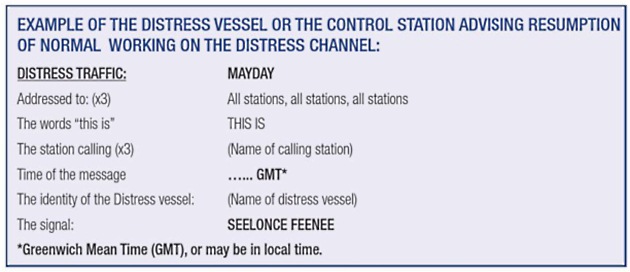
Transmission of a distress message by a station not itself in distress
A ship or coast station which learns of a vessel in distress may transmit a distress message on behalf of that vessel when:
- the distress vessel cannot transmit a distress message; or
- although not in a position to assist, a vessel in the vicinity has not heard an acknowledgement; or
- the master, skipper, or the person responsible for distress communications, a Maritime Mobile Traffic: Charges for Radio, Telex, and Satellite Servicesmaritime communication station or a limited coast station considers that further assistance is necessary.
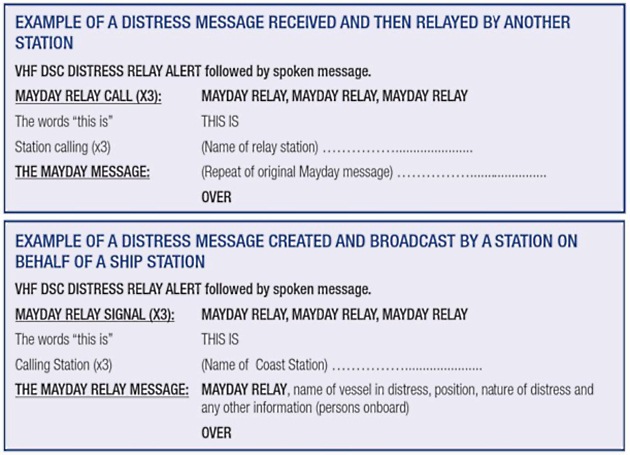
The urgency signal
The urgency signal consists of the words PAN PAN, and indicates that the caller has an urgent message to transmit concerning the safety of the vessel, aircraft or person. It has priority over all other communications except distress.
The urgency signal may be used to precede a message concerning a man overboard where urgent assistance is required to locate that person.
The urgency message may only be sent on the authority of the master, skipper or person responsible for the safety of the vessel. The urgency message may be broadcast to all stations on the distress, urgency or safety channel (Ch16) or to an individual station on a working channel after the announcement on Ch16.
A lengthy urgency message requesting medical advice or assistance, or repetition of a message relating to a vessel overdue would also be transmitted on a working channel. The caller may request an acknowledgement for the reception of such a message.
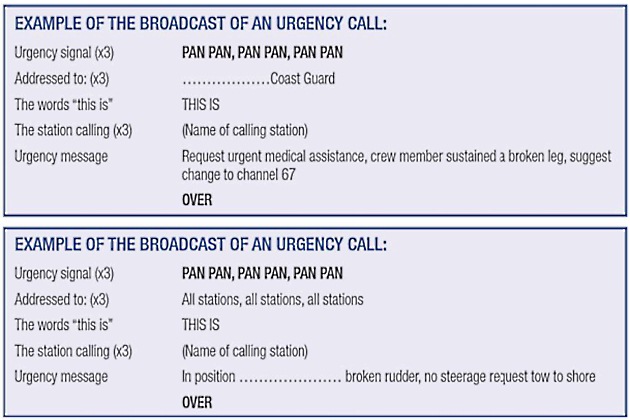
The urgency situation should be cancelled by the station of origin once the urgency situation is finalised.
The safety signal
The safety signal consist of the word SECURITE (pronounced SAY-CURE-E-TAY), and indicates that the caller is about to broadcast a message concerning an important navigational or weather warning. It has priority over all other messages except distress or urgency messages.
The safety warning is announced on the distress, urgency or safety channel (Ch 16) with the safety message being broadcast on a working channel. An acknowledgement is not required.
